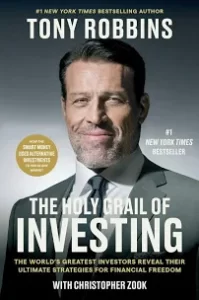
By Michael J. Wiener
Special to Financial Independence Hub
Tony Robbins’ latest book, The Holy Grail of Investing, written with Christopher Zook, is a strong sales pitch for investors to move into alternative investments such as private equity, private credit, and venture capital.
I decided to give it a chance to challenge my current plans to stay out of alternative investments. The book has some interesting parts — mainly the interviews with several alternative investment managers — but it didn’t change my mind.
The book begins with the usual disclaimers about not being intended “to serve as the basis for any financial decision” and not being a substitute for expert legal and accounting advice. However, it also has a disclosure:
“Tony Robbins is a minority passive shareholder of CAZ Investments, an SEC registered investment advisor (RIA). Mr. Robbins does not have an active role in the company. However, as shareholder, Mr. Robbins and Mr. Zook have a financial incentive to promote and direct business to CAZ Investments.”
This disclosure could certainly make a reader suspect the authors’ motives for their breathless promotion of the benefits of alternative investments and their reverence for alternative investment managers. However, I chose to ignore this and evaluate the book’s contents for myself.
The most compelling part of the pitch was that “private equity produced average annual returns of 14.28 percent over the thirty-six-year period ending in 2022. The S&P 500 produced 9.24 percent.” Unfortunately, the way private equity returns are calculated is misleading, as I explained in an earlier post. The actual returns investors get is lower than these advertised returns.
Ray Dalio and uncorrelated investment strategies
The authors frequently repeat that Ray “Dalio’s approach is to utilize eight to twelve uncorrelated investment strategies.” However, if the reported returns of alternative investments are fantasies, then their correlation values are fantasies as well. I have no confidence as an investor that my true risk level would be as low as it appears.
Much of the rest of the authors’ descriptions of alternative investments sounds good, but there is no good reason for me to believe that I would get better returns than if I continue to own public equities.
I choose not to invest in individual stocks because I know that I’d be competing against brilliant investors working full-time. I don’t place my money with star fund managers because I can’t predict which few managers will outperform by enough to cover their fees. These problems look even worse to me in the alternative investment space. I don’t lack confidence, but I try to be realistic about going up against the best in the world.
I found the most interesting part of the book to be the interviews with alternative investment managers. One example was Vinod Khosla saying “Both in our entrepreneurs and who we hire, the single most important factor is not what they know, but their rate of learning.”
The future of China, Korea and Japan
Another was Michael B. Kim’s take on the future of China, Japan, and Korea. He has bet his career “that China will resume its economic and financial market liberalization drive.” I hope he’s right, because China’s current path seems dangerous for the world.
These managers’ perspectives are enlightening, but not useful to my investment approach. It would be easy to see these managers as part of a world I’d like access to for social climbing purposes. It’s tempting to seek to be part of the rich guy club, but that would give me feelings of status without necessarily making me more money. I’d rather stick to a simple plan that requires very little of my time instead of wasting my time chasing status.
In conclusion, I’m not persuaded to invest in alternative assets, despite the authors’ breathless pitch. The view into the world of alternative investments was interesting in places, but not enough for me to risk my capital.
Michael J. Wiener runs the web site Michael James on Money, where he looks for the right answers to personal finance and inves ting questions. He’s retired from work as a “math guy in high tech” and has been running his website since 2007. He’s a former mutual fund investor, former stock picker, now index investor. This blog originally appeared on his site on June 2, 2024 and is republished here with his permission
ting questions. He’s retired from work as a “math guy in high tech” and has been running his website since 2007. He’s a former mutual fund investor, former stock picker, now index investor. This blog originally appeared on his site on June 2, 2024 and is republished here with his permission

